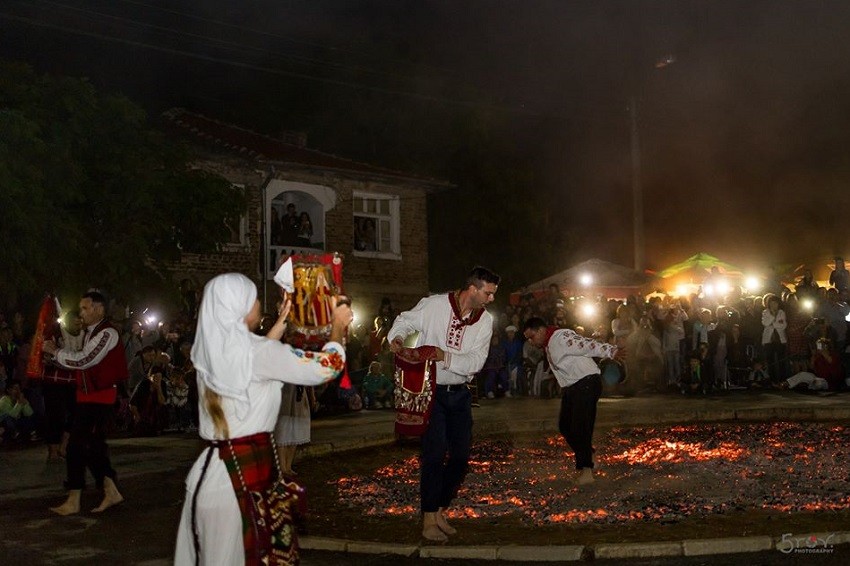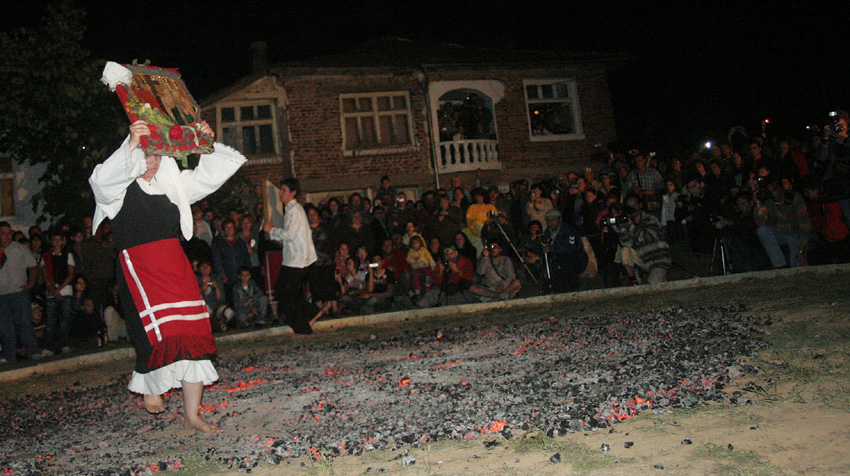“Believe and ask no questions!” - this is the answer Bulgarian scientists invariably get when they try to unravel the depths of the mystery of the nestinari (fire-dancers). This is the answer you yourself will get if you try to learn more from the horse’s mouth – that is if you talk to one of the few initiated in the sacral fire dancing. Some of the people who step into the fire and perform the ritual have made it a tourist attraction. Tourists can see them most of all in Bulgarian seaside resorts. The guardians of the true tradition from Strandja mount say the dancers apply different methods to protect their feet from burns. And the fire they make is of timber which burns at a lower temperature.
Fire-dancing in this country is performed in several villages in Southeastern Bulgaria hidden away between the one-time difficult of access Black Sea coast and the green hills of Strandja. Once, the nestinari were a closed community of a dozen families who would never marry outside the group, because fire-dancing was only handed down within the family. The ritual culminates in dancing on live embers. This is done twice a year, always within the space of three days. But these three days are preceded by a lot of preparations and secret rituals. In summer fire-dancing is performed on or during the days right before or after St. Constantine and Helena day, and ends outdoors. In winter – between January 18 and 20, when the nestinari walk on the fire of the sacred fireplace indoors. The main cult is of St. Constantine - God’s representative on Earth. The church once persecuted the nestinari because their cult practices were pagan. Because of these attacks against the proponents of tradition, the ritual was all but forgotten over a long period of time. That is also why the nestinari would keep outsiders at bay. In the 1930’s, academician Mihail Arnaudov studied the mysterious ritual and had the good fortune of talking to some of the legendary nestinari. He formed the opinion that this practice was connected with “Central Asian shamanism and its ecstasies, spells, prophecies and miraculous healings.” The scholar found similarities with the cult of Dionysus and asserts that this is a “mixed Semitic-Greek cult.”

“On May the first, the start of the Constantine month, as it is called in the region of Strandja, the participants in the ritual go to the house of the head nestinar", prominent Bulgarian ethnographer Dimitar Marinov wrote at the turn of the 20th century. And each would bring rakia, wine, banitsa or other kinds of food for the meal they would share. His guests would kiss his hand, place what they had brought on the table and go to the church together – the sacral centre of the nestinari ritual. In olden times it was in the home of the head nestinar. Here is how Dimitar Marinov describes the ritual: “Here he or she (the head nestinar) was the priest. He would thurify the icons and the attendant nestinari each of whom would be holding a burning wax taper brought from their homes…” After the ritual was completed it was said that “the spiritual power, the inspiration of St. Constantine had been passed on to everyone and they were all nestinari.”
In Bulgarian literature we find a description of the nestinari ritual in a short story by Konstantin Petkanov, which inspired the dance drama Nestinarka (female fire-dancer) by Marin Goleminov. In 1939 before starting work on the musical score, the then young composer decided to experience the atmosphere of the ancient ritual. As he put it, it was dying out and was preserved in just one Strandja village – Vourgari (Bulgarians). “It is a feast of St. Constantine and Helena. Their icons are kept at one of the houses in the square. On the eve of the feast day, people go there and light candles to the sound of a beating drum, but there is no priest. The women nestinari remain inside the house drinking rakia and come out from time to time to raise their hands and exclaim Woe is me! Woe is me! And these cries meant something bizarre, something terrible was going to happen. Goleminov describes the procession with icons of the two saints next to the hallow ground to the sound of a drum which is considered a sacred instrument and is kept in the church for one whole year. He also writes about the horo dance which must be joined by all and sundry for at least a few minutes – for health and success.

“In the evening the nestinari came, “Marin Goleminov goes on with his description. “They spread the embers and one of them took up the icon. She crossed herself and started walking to the accompaniment of a bagpipe and a drum. Finally the nestinarka grew pale, went into a trance and was “possessed”. Because if during the day you were to ask them whether they would be dancing in the evening, they answer: “If I am possessed.” And they are…”
This is a state the nestinari call “straying”. When they “stray” they utter prophecies. People believe that these prophecies always come true so they listen very attentively to what the fire-dancers will say. Numerous testimonies have come down to us of people who have attended the fire ritual and have been miraculously healed.
English version: Milena Daynova
Photos: BGNES, Geogui Iliev